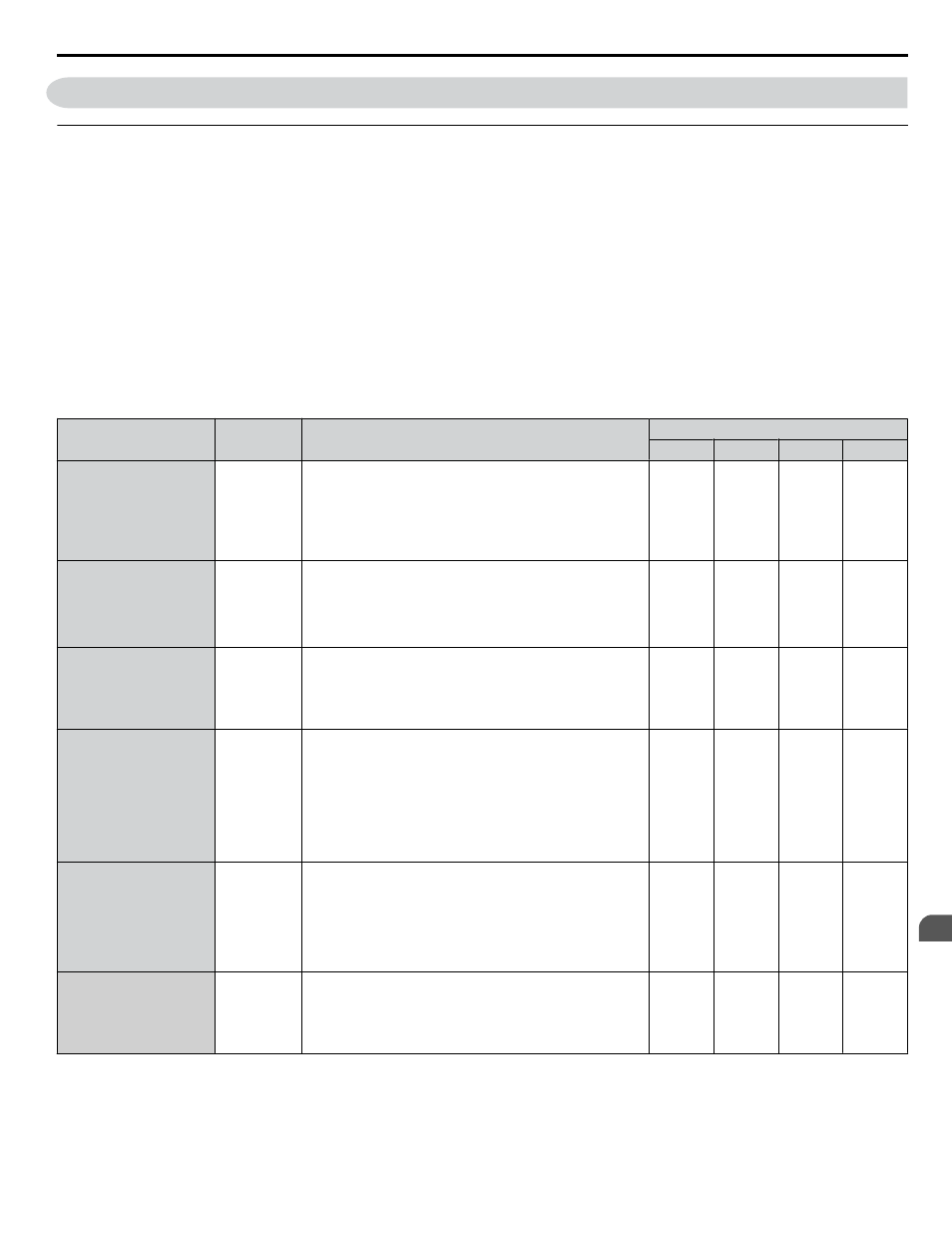7 auto-tuning, Types of auto-tuning, Automatic tuning sets motor parameters – Yaskawa CIMR-AU 200V Drives User Manual
Page 187: Auto-tuning

4.7 Auto-Tuning
u
Types of Auto-Tuning
The drive offers different types of Auto-Tuning for induction motors and permanent magnet motors. The type of Auto-Tuning
used differs further based on the control mode and other operating conditions. Refer to the tables below to select the type of
Auto-Tuning that bests suits the application.
Refer to Start-Up Flowcharts on page 151
for directions on executing Auto-
Tuning.
Note:
The drive will only show Auto-Tuning parameters that are valid for the control mode that has been set in A1-02. If the control mode is for
an induction motor, the Auto-Tuning parameters for PM motors will not be available. If the control mode is for a PM motor, the Auto-
Tuning parameters for induction motors will not be available. Inertia Tuning and ASR Gain Tuning parameters and setting options will be
visible only when the drive is set for operation with CLV or CLV/PM.
n
Auto-Tuning for Induction Motors
This feature automatically sets the V/f pattern and motor parameters E1-oo and E2-oo (E3-oo, E4-oo for motor 2) for
an induction motor. Additionally, the feature also sets some F1-oo parameters for speed feedback detection in Closed Loop
Vector.
Table 4.28 Types of Auto-Tuning for Induction Motors
Type
Setting
Application Conditions and Benefits
Control Mode
V/f
V/f w/PG
OLV
CLV
Rotational Auto-Tuning
T1-01 = 0
• Motor can be decoupled from the load and rotate freely
while Auto-Tuning is performed.
• Motor and load cannot be decoupled but the motor load is
below 30%.
• Rotational Auto-Tuning gives the most accurate results,
and is recommended if possible.
–
–
YES
YES
Stationary
Auto-Tuning 1
T1-01 = 1
• Motor and load cannot be decoupled and the load is higher
than 30%.
• A motor test report listing motor data is not available.
• Automatically calculates motor parameters needed for
vector control.
–
–
YES
YES
Stationary
Auto-Tuning 2
T1-01 = 4
• Motor and load cannot be decoupled and the load is higher
than 30%.
• A motor test report is available. After entering the no-load
current and the rated slip, the drive calculates and sets all
other motor-related parameters.
–
–
YES
YES
Stationary Auto-Tuning
for Line-to-Line
Resistance
T1-01 = 2
• The drive is used in V/f Control and other Auto-Tuning
selections are not possible.
• Drive and motor capacities differ.
• Tunes the drive after the cable between the drive and motor
has been replaced with a cable over 50 m long. Assumes
Auto-Tuning has already been performed.
• Should not be used for any vector control modes unless the
motor cable has changed.
YES
YES
YES
YES
Rotational Auto-Tuning
for V/f Control
T1-01 = 3
• Recommended for applications using Speed Estimation
Speed Search or using the Energy Saving function in
V/f Control.
• Assumes motor can rotate while Auto-Tuning is executed.
Increases accuracy for certain functions like torque
compensation, slip compensation, Energy Saving, and
Speed Search.
YES
YES
–
–
Stationary
Auto-Tuning 3
T1-01 = 5
• A motor test report listing motor data is not available.
• Motor can be driven with a normal duty mode after Auto-
Tuning. A trial run is performed after Auto-Tuning to
automatically calculate motor parameters needed for vector
control.
–
–
YES
YES
The necessary information is usually listed on the motor nameplate or in the motor test report provided by the motor
Refer to Subchart A-1: Simple Motor Setup Using V/f Control on page 153
Performance Operation Using OLV or CLV on page 154
for details on Auto-Tuning processes and selections.
4.7 Auto-Tuning
YASKAWA ELECTRIC TOEP C710616 41E YASKAWA AC Drive - A1000 Quick Start Guide
187
4
Start-Up Programming & Operation